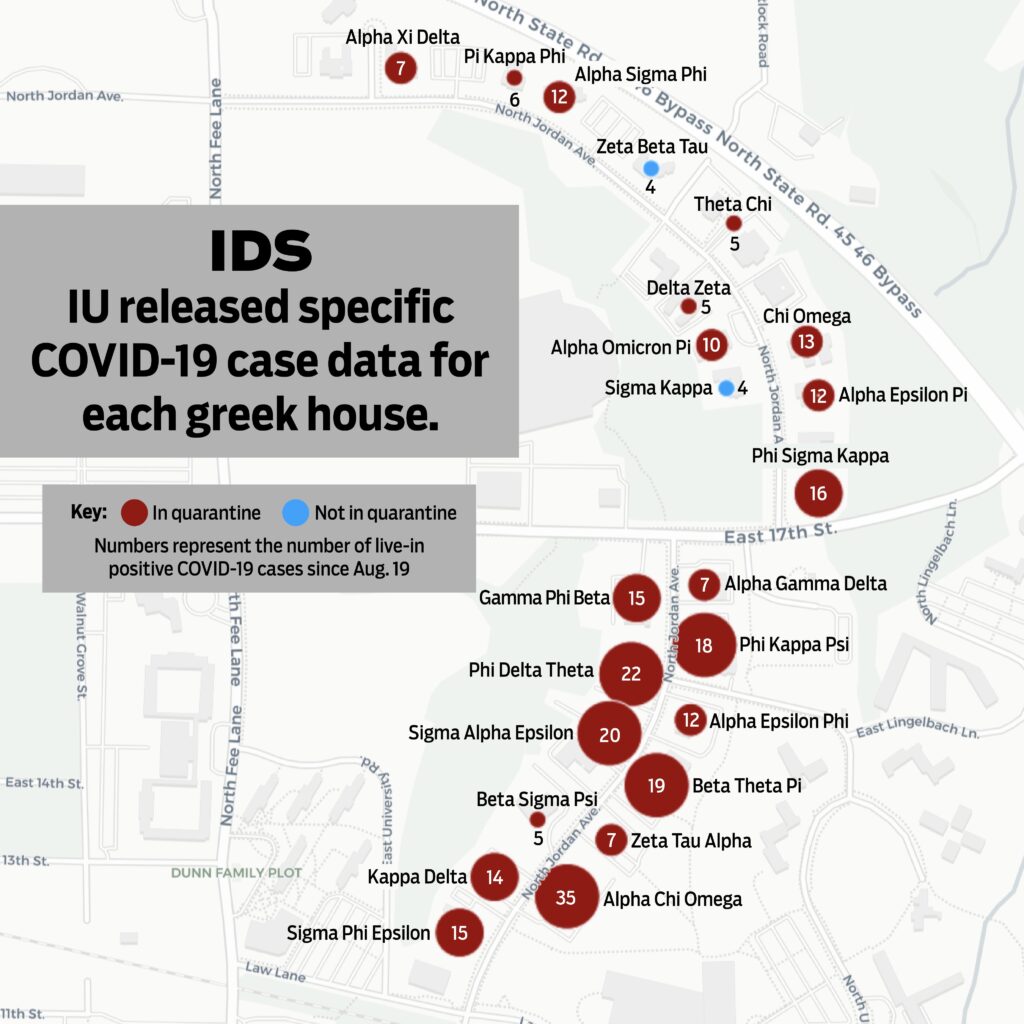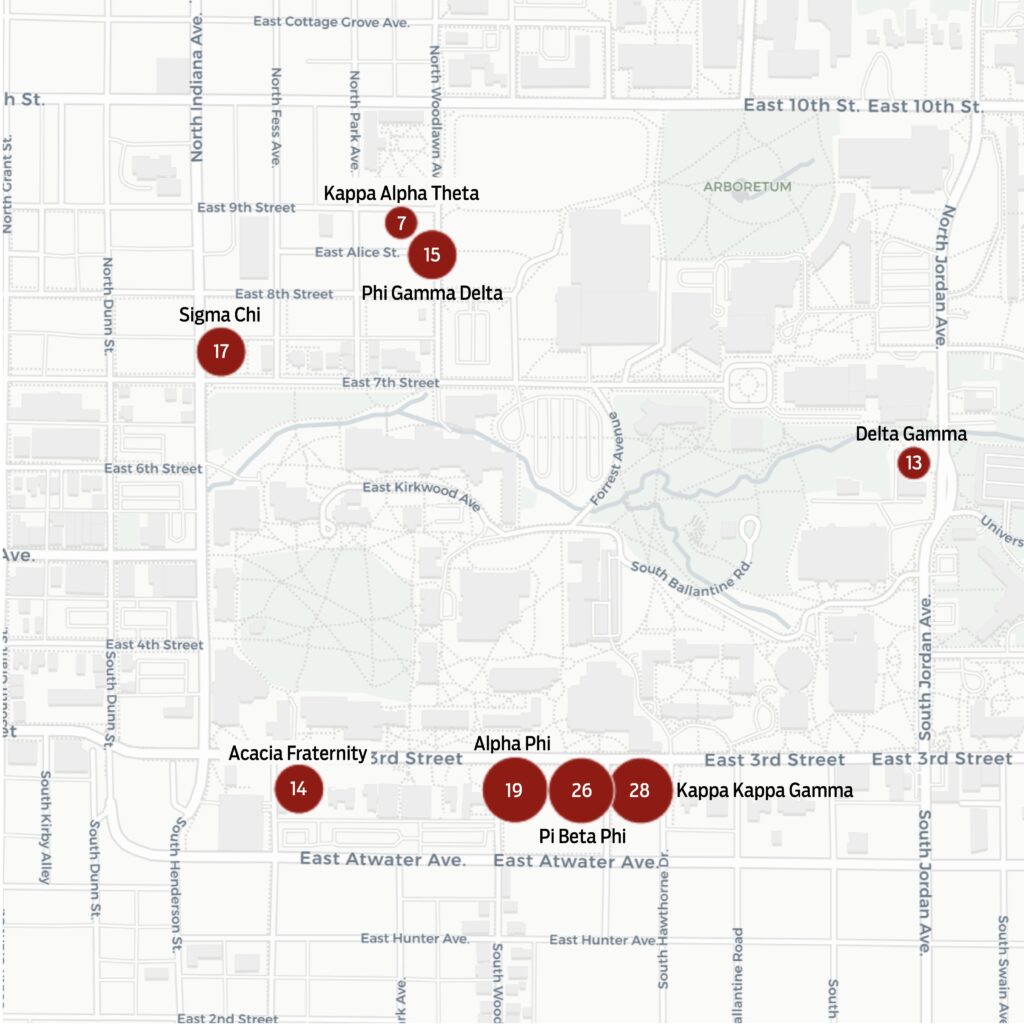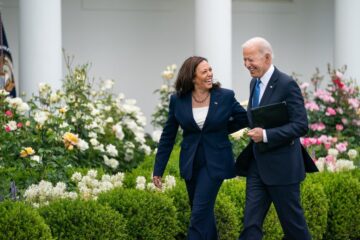Welcome back to Week 21 in my weekly reports analyzing the Covid-19 pandemic and its effects on the country and higher education, and welcome to our new subscribers!
I have been following the pandemic since the first outbreak in Wuhan in January, during which time I was in China. As I have reported previously on this blog, I was in Beijing studying abroad when the coronavirus outbreak prompted our program to abruptly suspend operations and students had to quickly repatriate to the United States. Since the beginning of the outbreak, I have spoken to a number of media outlets to discuss the situation and my reporting. For those of you reading this on my blog, Off the Silk Road, I have also launched a newsletter, where these reports can be sent directly to your email each week. Click here to subscribe.
Last week, we discussed considerations for colleges opening in the fall and cautioned against misinformation and disinformation. This week, we will take a closer look at the latest college outbreaks as most fall semesters are underway, and examine parallels in the higher ed world with those on a national level.
A national look
Think of Labor Day as a supercharger engine. Cases are expected to increase over the holiday weekend. Going into Memorial Day we were averaging around 22,000 cases per day nationwide. Now we are averaging 40,000. The American public must do all it can to slow the spread this holiday weekend. We cannot undo the progress we have made, with close to 1,000 Americans losing their lives every day. A “spike” following Labor Day could be felt as early as mid-September.
One of the statistical explanations for a reduction in the case-fatality rate is an uptick in the number of young people testing positive, as seen from this CDC data. This is only expected to increase due to schools and colleges reopening.
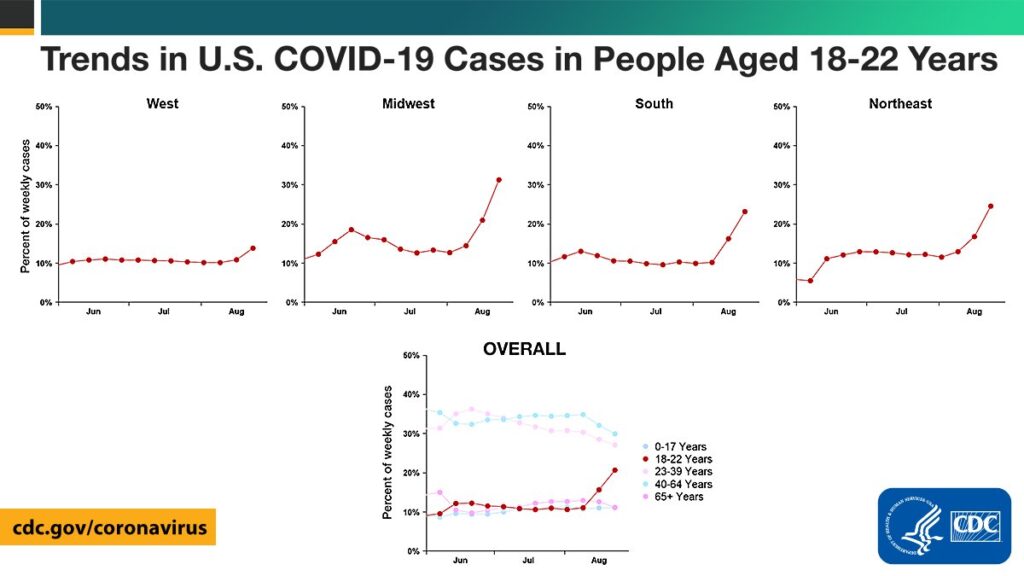
Equally concerning as a spike in cases among young people is a new “expert” in the White House, Dr. Scott Atlas. Not an infectious disease specialist, but a radiologist, Dr. Atlas has been pushing the White House to embrace a “herd immunity” strategy, which would result in an estimation of 2.13 million American lives lost. “I think Trump clearly does not like the advice he was receiving from the people who are the experts — Fauci, Birx, etc. — so he has slowly shifted from their advice to somebody who tells him what he wants to hear,” infectious disease specialist Dr. Carlos del Rio said to The Washington Post. Dr. Atlas is a threat to American public health.
Let’s take a look at some of the latest scientific developments:
- According to a CDC study, prevalence of SARS-CoV-2 antibodies was lower among personnel who reported always wearing a face covering while caring for patients (6%), compared with those who did not (9%). PPE works!
- Advisers at the National Institutes of Health (NIH) have said the data for convalescent plasma are insufficient to justify an Emergency Use Authorization.
- A new study published in JAMA Internal Medicine shows evidence for airborne transmission in the analysis of a bus outbreak in China.
- According to a new article in The Atlantic, shouting and other activities that involve exhaling large amounts of droplets could accelerate viral transmission.
- Researchers are struggling to tally mortality statistics as the pandemic rages, using a concept known as “excess deaths.”
- A WHO analysis found that inexpensive steroids such as dexamethasone reduce deaths of hospitalized Covid-19 patients.
- A new study published in BMJ reports that it can take 30 days on average for viral elements to clear the body, though patients are still only contagious from around 10 days after symptom onset.
- According to a CDC report, prescriptions for hydroxychloroquine increased by 80-fold in March 2020 compared to March 2019.
- Vaping could put individuals at increased risk for Covid-19.
- Researchers at Yale found that pooling saliva samples for testing could help increase capacity.
- A select subcommittee in Congress just released eight weeks of coronavirus reports that had been kept secret by the White House. These data need to be made public in a timely manner.
Finally, some updates on vaccines.
- A poll found most Americans believe the Covid-19 vaccine approval process is driven by politics, not science.
- A U.S. advisory group lays out detailed recommendations on how to prioritize distribution of a Covid-19 vaccine.
- The Trump administration said it will not join a global effort to develop, manufacture and equitably distribute a coronavirus vaccine, in part because the World Health Organization is involved. This will be catastrophic.
- It is possible that a vaccine may be approved sometime this fall. However, to achieve maximum vaccine-induced herd immunity we need two factors to be as high as possible: vaccine effectiveness and vaccine trust. The more people trust the vaccine, the more they will want to be vaccinated. This comes as a poll shows close to one half (42.4%) of participants indicated hesitancy to be vaccinated against Covid-19 when a vaccine becomes available.
- Dr. Moncef Slaoui, the leader of Operation Warp Speed, said in an interview with Science magazine that he will quit if politics trumps science, despite the Trump administration putting intense pressure on the FDA to approve a vaccine in time for the president’s re-election bid.
- Data from Phase I/II trials from Russia’s vaccine show that the vaccine elicited a robust immune response; however this was a small sample size and more trials will be needed to guarantee safety and efficacy.
As we move on to our discussion of higher education, new predictions from the Institute for Health Metrics and Evaluation at the University of Washington show 325,907 deaths predicted by December 1 and 410,451 by January 1. Last week, the model predicted 317,312 deaths by December 1. While many health experts are skeptical about forecasting more than a few weeks in advance, it is clear that the U.S. could be in for a dark fall. But wait, there is a national strategy! Trump wants to narrow the administration’s coronavirus testing strategy. “The challenge is that they didn’t want to find more cases. They didn’t want the numbers to keep going up,” one senior Republican official said to Politico. This decision will cost lives.
Higher education
Colleges are “building the plane as they fly it,” senior editor at The Chronicle of Higher Education Andy Thomason said in an interview with WBUR. After spending the last few months analyzing college fall plans and now seeing more and more walk them back before or after students arrive on campus, I see this could not be more true. This week, I launched a tracker in partnership with Inside Higher Ed monitoring changes to colleges’ fall plans.
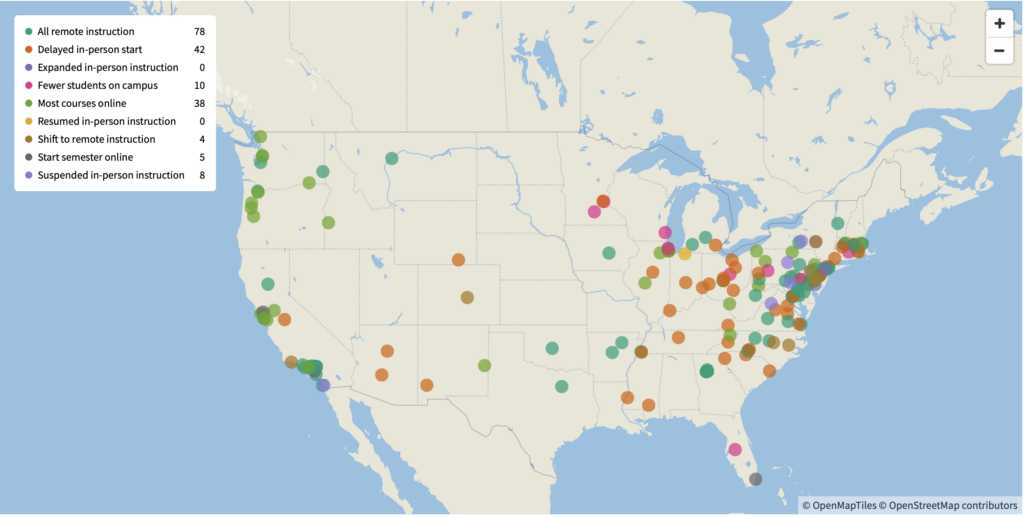
Duke professor Dr. Gavin Yamey says that college outbreaks constitute a national “third wave” of infections — after the initial round of cases in New York and this summer’s influx in the South and West. I have repeatedly stated on this blog that higher ed cannot exist in a vacuum and must depend on the national picture. In the state of Iowa, for example, we have seen this convergence of these two forces in a major way. Cases in Johnson and Story Counties, where the University of Iowa and Iowa State University respectively are located, spiked following students moving in.
Both universities do not record new cases on a daily basis, so I aggregated it by week (we do not have data for ISU from the last week in August). In Johnson County, UI cases count for anywhere between 30% and 100% of the county’s weekly cases. This is staggering.
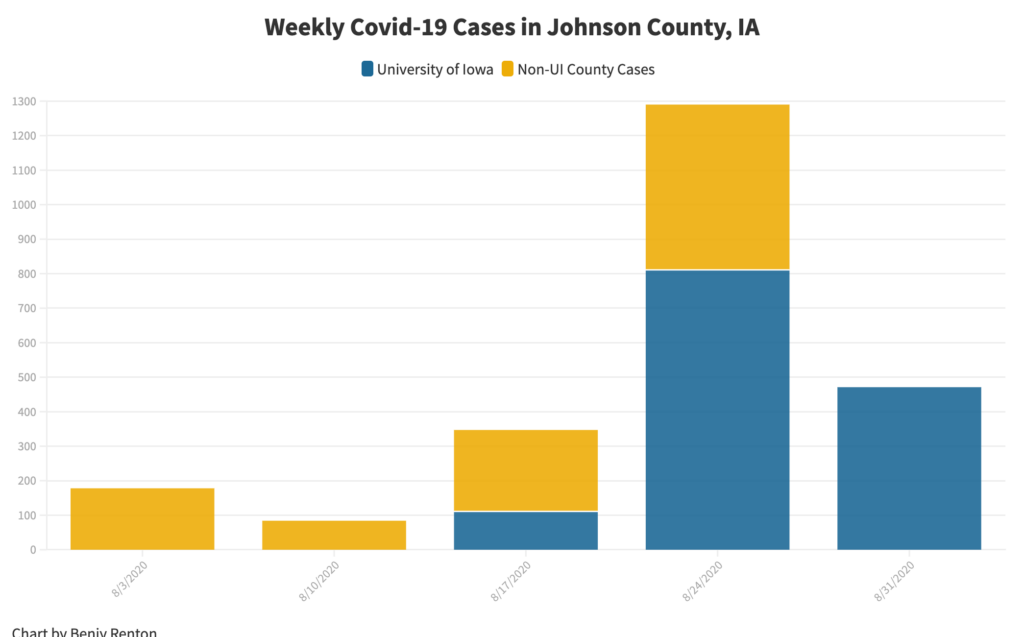
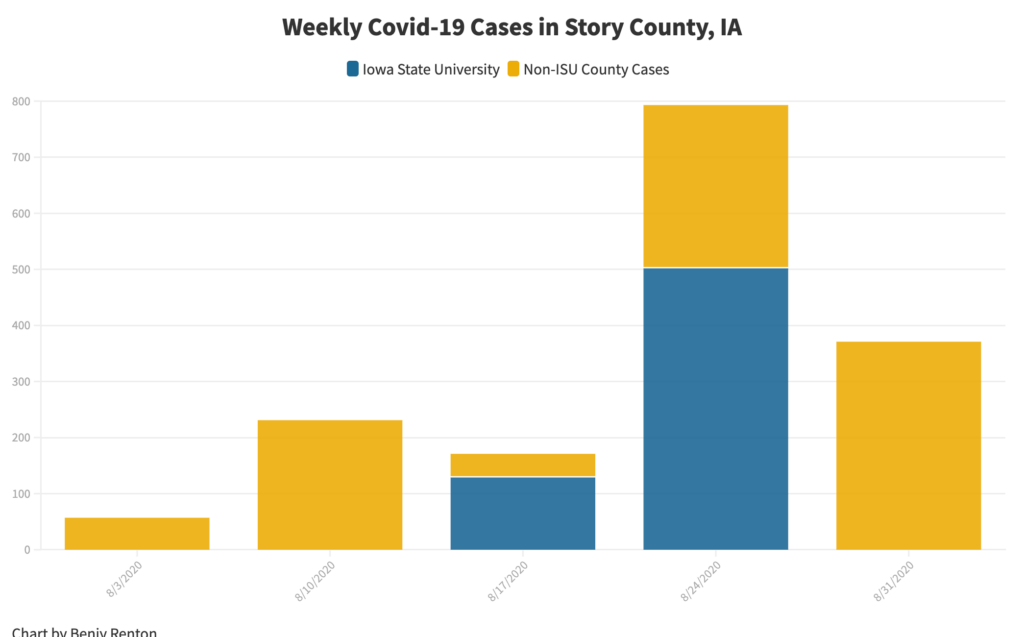
Another area of concern is test positivity — Johnson and Story Counties stand out as having positivity rates of over 20%. Iowa has now become a Covid-19 hotspot, primarily driven by these two outbreaks. Similar incidents have occurred in other counties as well, as reported by the Chronicle’s Francie Diep.
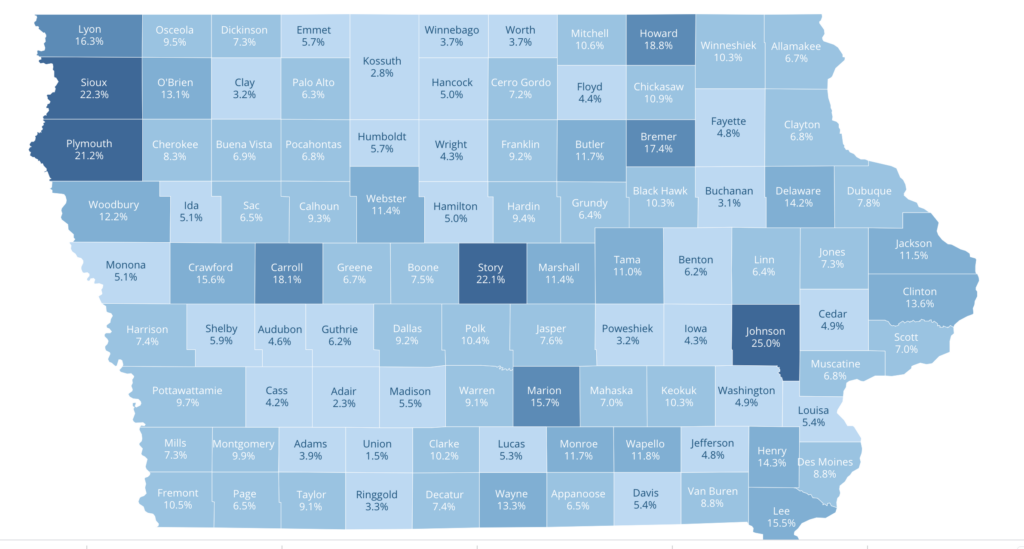
The same patterns we have seen in higher ed over the summer have continued to repeat themselves. Colleges hire student ambassadors to “police” student behavior, as my colleague Alison Berg reports in the Chronicle. Some choose to dismiss students for partying. Others withhold their outbreak numbers under so-called privacy laws that legal experts say do not cover case counts, as they are not personally identifiable information. Over the last few months we’ve discussed a need for colleges to publicly post “thresholds” — how many cases it will take to move a university online. What we are seeing is a real-life threshold experiment, and some colleges have more tolerance than others. While James Madison University had over 600 cumulative cases when they flipped to online, Colorado College had less than 10, with 3 first-year dorms quarantined. With the 16 schools I have currently tracked as going remote after students have arrived on campus, the mean number of days from the start of classes to the shift announcement is 7.2. This is depressing and I expect it to keep happening as the semester rolls on.
After you see an outbreak on campus, what are a college’s next steps? On Wednesday, Dr. Anthony Fauci urged schools not to send students home. I think we will begin to see colleges imposing different types of lockdowns in an attempt to get their cases under control throughout the fall. This has happened this week at Gettysburg College and the University of Illinois. The University of Illinois outbreak is worthy of analysis. Despite having one of the most robust saliva testing systems in the country, testing all students twice a week, a few on-campus parties over the weekend prompted a rise in cases. Testing is a huge boost to any college reopening plan but must not be used as a panacea. It will take modifications of student behavior and other nonpharmaceutical interventions to truly control outbreaks and keep case numbers as low as possible. As the Broad Institute in Massachusetts continues to conduct testing for 108 schools in the Northeast, some schools still only believe testing symptomatic students will be enough to detect outbreaks (Spoiler alert: It will not be).
As colleges continue to reopen, some potentially influenced by state politics, I have created a new tool to help us detect outbreaks early and see rising case counts. This “College Watchlist” has three alert levels, Yellow, Orange and Red, based on cumulative case counts and the number of cases in the last 7 days. You can explore the map here.
Schools to watch this week include the University of Alabama, the University of South Carolina, Ohio State University and the University of Georgia, among others. One area where further research is needed is wastewater testing, which some colleges have employed to help detect outbreaks.
Greek life is also a huge issue, as seen from this map out of Indiana University, where the vast majority of Greek houses are under quarantine.
Each week, we take a moment to acknowledge the wacky, stupid and downright dumb elements of colleges’ reopening plans, also known as the College RidicuList.
- The University of Florida’s president Kent Fuchs said the only way the school would close again is if UF Health Shands Hospital became overloaded with patients.
- Iowa State University announced, then retracted, an invitation to host 25,000 fans at its first home football game.
- The University of Minnesota thinks that a 9 p.m. curfew will help control student behavior.
- The University of Kansas’ statement welcoming students back included this sentence: “It is essential because, as Physicist and Chemist Marie Curie said, ‘Nothing in life is to be feared, it is only to be understood. Now is the time to understand more, so that we may fear less.’”
- Bryn Mawr College‘s reasoning for not conducting more asymptomatic testing? “Testing currently misses up to 20% of all cases. That is why it is so important to focus our efforts on prevention.”
- A professor at Arizona State University required his students to move closer together in a classroom.
- Oklahoma University is allowing quarantined students to dine on campus and grocery shop before being cleared. This is not a quarantine.
- In the middle of a massive outbreak, the University of South Carolina had to cancel a testing day due to a lack of staff.
- Oklahoma University installed some hand sanitizer dispensers with a pigeon sticker on it. Watch the video for yourself.
Here are some samples from op-eds and editorials in student newspapers this week, which are always useful for capturing perspectives from students, faculty, staff and local community members.
- “We must wonder — is the risk of finding out worth it? The University should not be betting on lives.” The editorial board of the Cavalier Daily at the University of Virginia puts the onus on the administration: “We know that these infections and deaths are coming.”
- “MU’s administrative response following the decision to allow students back on campus may be fatal,” editors at the University of Missouri write.
- “You may be familiar with the saying that ‘snitches get stitches’ but keep your mouth shut, and people are going to be ending up on ventilators,” editors at the University of Florida write.
- “Let’s use this as an opportunity to stand strong against a mutual enemy, Covid-19, and stand together, as a Penn community,” one University of Pennsylvania student says. “Covid-19 is relentless — but we certainly don’t have to be.”
- “Are we in a public health crisis? Is this an emergency? Or are we just seeing a spike in cases of the coronavirus? We don’t know because IU won’t make its data public.” The editorial board at the Indiana Daily Student at the University of Indiana demands transparency from the institution.
- “Students must be responsible in their social and personal lives, but they can only do so when given the tools to succeed. Ambiguity and a lack of clarity in official communications have enabled dangerous and reckless behavior,” the editorial board at The Middlebury Campus writes.
- “With a lack of accountability and no transparency from UGA, we cannot properly inform the public,” the editorial board at the University of Georgia’s student newspaper writes. “Cases surged to a record level in Athens this week and topped 800 at UGA. How many are too many?”
- “If we’re beyond the point of no return and we need to close, tell us. If we actually have time to turn this around, prove to us that we’re staying open to take a second chance at it –– not because you’re waiting for tuition checks to cash,” editors at Virginia Tech write.
- “Guskiewicz, if you’re reading this: make some changes, or find someone who will.” The editorial board of The Daily Tar Heel pushes for the resignation of UNC’s chancellor.
- “I could finally imagine a happy return to campus, rather than one that was consumed by fear and shame,” Dartmouth College student Hannah Lang writes with useful suggestions for college administrators.
So where do we go from here? In an op-ed in BMJ, Dr. Gavin Yamey at Duke and Dr. Rochelle Walensky at Massachusetts General Hospital outline clear suggestions for college campuses if they want a chance at an in-person semester.
- Curb community transmission
- Quarantine before or on arrival
- Frequent testing and surveillance screening
- Blaming students will fail
Think of colleges as cities. As we saw this spring and summer, I expect to see rises and falls in case numbers across college campuses nationwide, all at different times. This analysis from data journalists Alana Drake and Patrick Sharp shows a rise in cases in many colleges after reopening.
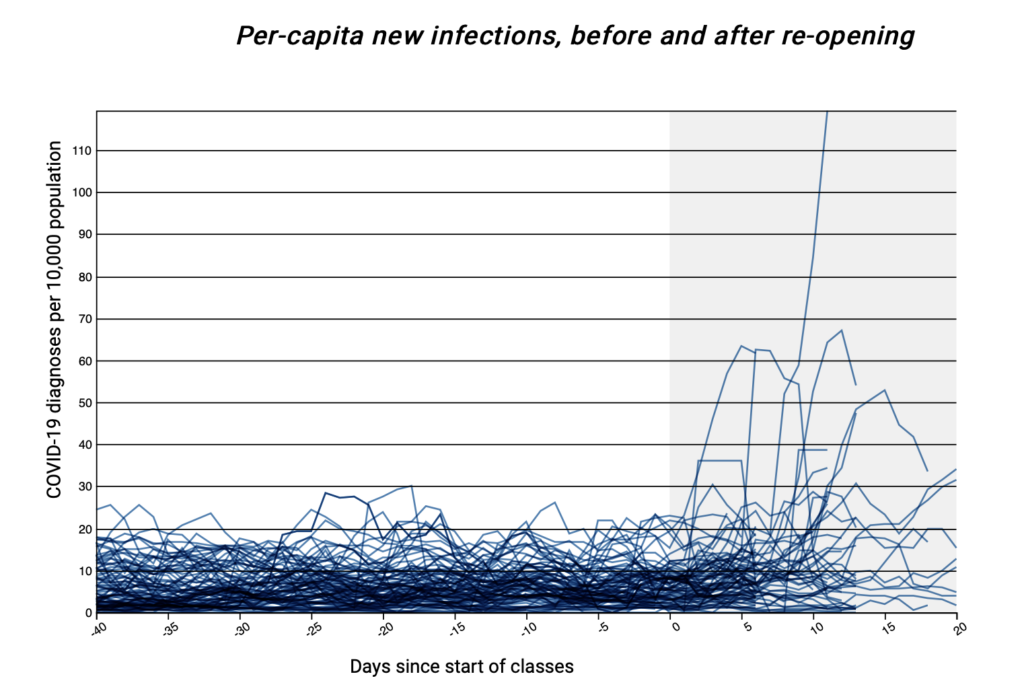
I am quite certain that the 51,000+ cases counted in The New York Times’ analysis of colleges nationwide is an undercount. Many off-campus cases do not seem to be reported in college dashboards, with quite a few only updated on a weekly basis. It is impossible to see spikes in cases when we only receive data once per week. At this rate, it may be a very long fall.
The Good Stuff
Let’s roll the clips of the good stuff. In my usual tradition, I feature my favorite stories from the week. Here are my Top 8.
- College voting activists are getting out the vote remotely, encouraging others to register.
- One former doctor ended up flying thousands of dogs in shelters across the country to save them.
- My colleague Maya Goldman and her boyfriend Ben Ratner spent almost 3 months visiting 148 of Ann Arbor, Michigan’s parks.
- A New York Times analysis found a correlation between political party affiliation and the amount of green space in the landscape.
- When the runway lights failed, Alaska residents used their car headlights to land a medevac plane.
- Reese’s made a breakfast cake so you can have dessert in the morning.
- The New York Times published a gripping series of portraits of hunger insecure individuals as a result of the pandemic.
- At the U.S. Open, the coronavirus has disrupted a crucial relationship: Player and towel.
Conclusion
Our fight against the pandemic this fall is just beginning. Still without an adequate national testing strategy (and none coming on the horizon), we remain unprepared for any potential spikes in cases as a result of Labor Day and schools and colleges reopening. If we do not make a concerted effort to do all we can to suppress transmission nationally, the virus will win. Testing, tracing and a clear public health message are critical. Professor of human geography at the University of Glasgow Felicity Callard notes: “Covid-19 is a very different disease from the one we thought it was in March. We now know it is multi-systemic, and it might turn out to be able to cause damage in anyone infected, even if asymptomatic. Yet I see no shift in public health messaging and campaigns to acknowledge this.” This comment is critical. We need to maintain an aggressive fight against this virus, or we will be in for an incredibly challenging fall and winter.
I’d like to thank all the student journalists with whom I have the pleasure of working. In the next weeks and months ahead, they will become vital in chronicling their colleges’ paths forward for the fall and beyond. Support their work by reading it.
My best to all for good health.
Like what you see? Don’t like what you see? Want to see more of something? Want to see less of something? Let me know in the comments. And don’t forget to subscribe to the weekly newsletter!
For more instant updates, follow me on Twitter @bhrenton.
